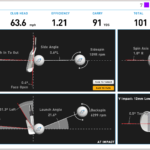Improve Faster by Swinging Slower
Photo by Augusta Golf Instruction
by: B. J. Hathaway
If patience is a virtue, then a lot of golfers are in serious trouble. Now I am not saying golfers are bad people, on the contrary, they are some of the finest people that I know, but patient is another story. It’s usually the serious golfer who decides to invest in his or her game with personal coaching, and if you are one of those golfers you should be commended. Golf as we know is a game of constant challenges in the goal of achieving perfection, which no one has been able to do yet.
For the golfers who take lessons or private coaching, this is written for you. The typical scenario goes something like this:
Coach: Ok Joe, or Jane, here’s the part of your swing that’s causing your ball flight error (in better cases slow motion video is used to show the problem). Here is what I want you to do to change it and here’s what it should feel like, now make some slow swings and see if you can feel it too.
Golfer: Ok Coach, I understand.
So Golfer Joe or Jane steps up to the golf ball and swings at 99% of their maximum speed, the ball flies sideways and Coach gets a look like “is that it?”
What our golfers need to realized is that just because you may understand something intellectually does not mean you can do it correctly. What is missing is an understanding of how we learn motor skills in a complex movement like the golf swing. Now Joe, or Jane, may understand they they’re coming “over the top” but does that mean they can immediately change it? Unfortunately the answer is usually no.
So Joe has seen his swing fault, he understands the problem, so why can’t he do it correctly. The answer is speed of movement and how we learn, especially as adults. You see, Joe’s swing faults are already built into his central nervous system and every time he swings the club he uses the movements that are stored deep in his memory. Joe’s brain says, “listen, this is how we do things around here” and even though he told his swing to do something different he cannot feel the change by moving at full speed.
The next problem is that Joe’s system of logic says that he in an adult and if he tells his body to do something it will listen and do it correctly immediately. Although it makes perfect sense to Joe, and to you and I, that’s not necessarily how we learn to change a complex movement. What Joe, and you, should consider is to try making the new movement at 20% of a normal swing speed so that the brain and body have enough time to sync together and feel the correct movement.
Another part of the problem is that Joe sees that there are 120 golf balls and 48 minutes remaining in his lesson time and he feels the need to hit all of those golf balls and get this thing done before his hour is up. This is something that we as coaches and you as golfers need to change, there’s just no evidence that 60 minutes will change the swing that you’ve been using for the last 12 years. Instead we need to develop a little bit of patience and learn to feel the correct movement at a pace that both our body and mind can absorb.
If you will learn to move slow enough to get the feel of a correct motion you can then learn to store that feel into memory and make real changes. Remember that it’s not logic alone that will change your swing, it’s the ability to see and feel the correct motion slow enough to be able to recognize and recall it. Once you own it, then you can do it faster and better. Learning is not just understanding, it’s all about feeling the right way to do it slow enough to make it yours.










